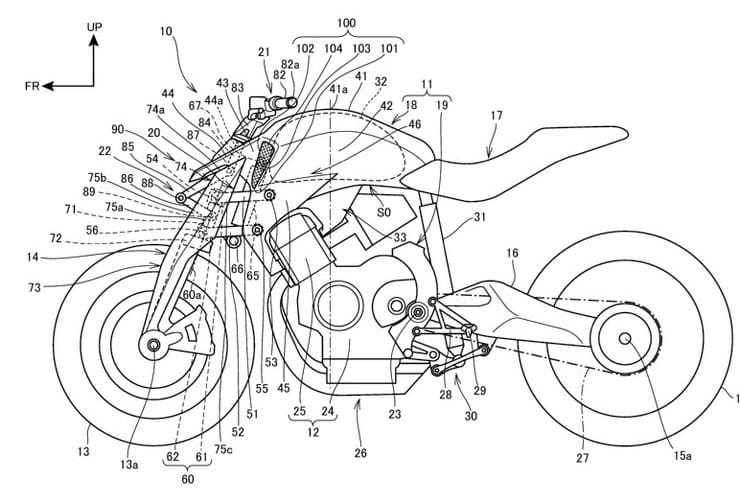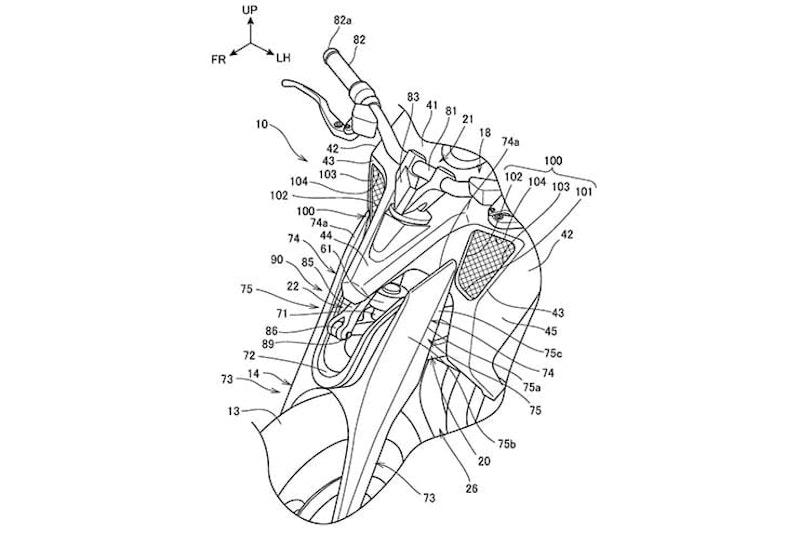Honda experiments with Hossack forks
By Ben Purvis
Motorcycle Journalist
07.06.2023
Norman Hossack’s girder-style fork design didn’t find many takers when it was first developed back in the 1970s but now, half a century later, you’ll find something similar on BMW’s K1600 models and Honda’s Gold Wing. Now Honda is looking at a previously unexplored benefit of the system by applying it to a CB1000R-style naked bike in pursuit of improved aerodynamics.
The Hossack system replaces telescopic front forks with a solid girder, shaped like an inverted Y, to hold the front wheel. A parallel pair of car-style suspension wishbones extend forward from the chassis above the front wheel to connect it to the girder fork, with a single coil-over shock mounted between them, and the bars are connected by a simple, hinged linkage.
Normally, the quoted advantage of the Hossack setup is the freedom it offers in terms of geometry and setup. The one-piece fork can be made hugely rigid longitudinally to counter braking forces that try to bend it backwards, while being slimmer when seen from the front, allowing the level of lateral flex to be tailored. Some side-to-side movement can be beneficial, absorbing bumps during hard cornering. The Hossack fork geometry can also be tailored to reduce braking dive without having to make the front spring stiffer.
These benefits explain why the design has been chosen for the BMW K1600 and Honda Gold Wing, but on the latest Honda patent there’s an additional objective in the form of aerodynamic efficiency.
Normally, naked bikes are an aerodynamic disaster. Not only do they present a bluff front end to the oncoming wind, but they do little or nothing to deflect air around the rider. However, the Honda Hossack forks seen here help mitigate the normal problems.
The slim frontal aspect of the fork legs mean they can be tucked tight against the sides of the front wheel, and because they’re either cast alloy or some sort of carbon composite, they can be shaped to slice through the air more cleanly than the circular cross-section of a normal telescopic fork could manage.
Above the wheel, the one-piece girder fork takes on an even more aerodynamic shape, with chamfered front corners that channel air upwards and sideways into air intakes on the shoulders of the fuel tank. That promises an additional performance gain, as the messy aerodynamics of conventional naked roadsters mean they benefit less from ram-air boost than faired bikes.
The forks might grab you attention first, but they’re coupled to a chassis that’s specifically designed to make the most of their advantages.
It’s a two-piece frame, using the engine as a fully stressed member. The front frame section bolts to the top of the engine and is a single casting supporting the front suspension and the steering head before arching back over the top of the fuel tank to the rider’s seat. At the back, the rear of this upper frame provides the top mount for an unusually long rear suspension strut.
The single-sided swingarm, with a conventional rising-rate suspension linkage slung beneath it, is mounted on a separate rear half-frame that bolted to the back of the gearbox.
The front, upper chassis layout has more than a passing similarity to that of the legendary Britten V1000 superbike, which also featured Hossack suspension and took an unconventional route to aerodynamic efficiency.
As usual with patents applications, it would be premature to leap to the conclusion that this is an upcoming production bike, but Honda is known to be working on a high-performance naked bike to replace the current CB1000R. Another patent, filed last year, showed an unfaired superbike, again with a two-piece chassis, designed around the last-generation Fireblade engine and fitted with large front winglets. It was a more likely real-world design than the Hossack-forked setup seen here but shared several similarities including the single-sided swingarm.
Honda has also been showing a surprising amount of interest in Hossack-style forks. Following on from the Gold Wing’s introduction with the setup, the company filed several patents showing other bikes with a similar system, including a CB1100F, a C125 Super Cub and even a version of the RC213V MotoGP bike. With so much R&D effort being put into the idea, it would be foolish to write off the possibility of more Hondas getting an alternative front suspension in the not-too-distant future.
Share on social media:

